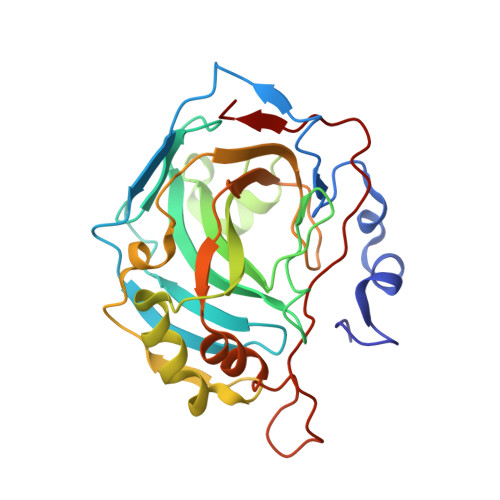Structural study of interaction between brinzolamide and dorzolamide inhibition of human carbonic anhydrases.
Pinard, M.A., Boone, C.D., Rife, B.D., Supuran, C.T., McKenna, R.(2013) Bioorg Med Chem 21: 7210-7215
- PubMed: 24090602
- DOI: https://doi.org/10.1016/j.bmc.2013.08.033
- Primary Citation of Related Structures:
4M2R, 4M2U, 4M2V, 4M2W - PubMed Abstract:
Carbonic anhydrases (CAs, EC 4.2.1.1) are metalloenzymes that catalyze the reversible hydration of carbon dioxide and bicarbonate. Their pivotal role in metabolism, ubiquitous nature, and multiple isoforms (CA I-XIV) has made CAs an attractive drug target in clinical applications. The usefulness of CA inhibitors (CAIs) in the treatment of glaucoma and epilepsy are well documented. In addition several isoforms of CAs (namely, CA IX) also serve as biological markers for certain tumors, and therefore they have the potential for useful applications in the treatment of cancer. This is a structural study on the binding interactions of the widely used CA inhibitory drugs brinzolamide (marketed as Azopt®) and dorzolamide (marketed as Trusopt®) with CA II and a CA IX-mimic, which was created via site-directed mutagenesis of CA II cDNA such that the active site resembles that of CA IX. Also the inhibition of CA II and CA IX and molecular docking reveal brinzolamide to be a more potent inhibitor among the other catalytically active CA isoforms compared to dorzolamide. The structures show that the tail end of the sulfonamide inhibitor is critical in forming stabilizing interactions that influence tight binding; therefore, for future drug design it is the tail moiety that will ultimately determine isoform specificity.
Organizational Affiliation:
Department of Biochemistry and Molecular Biology, College of Medicine, University of Florida, Box 100245, Gainesville, FL 32610, USA.
















